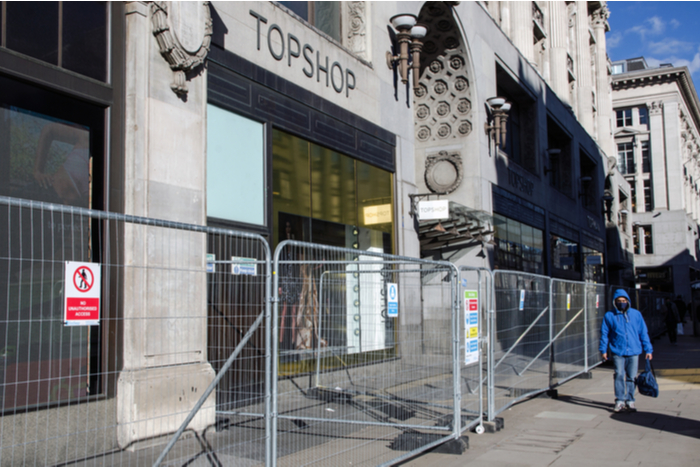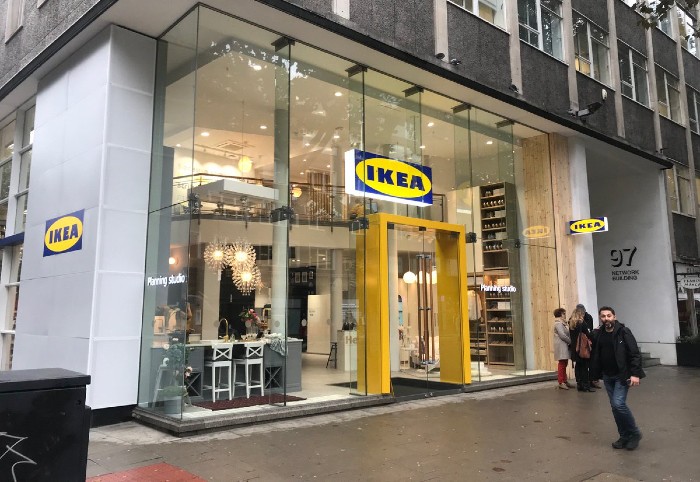Ikea appears to be going all-in on its strategy to attract more urban millennials by inching further away from its iconic warehouse-like stores.
The Swedish homewares and furniture giant was recently in advanced talks to take over the former Topshop flagship store on London’s Oxford Street as part of its plan to open more smaller-format outlets in city centres.
Since Arcadia Group’s administration in December, various Topshop stores became vacant across the country – with the most iconic one being the Topshop flagship.
The store – which launched a sale process with a £420 million price tag earlier this month – has since been circled by a number of retailers, including JD Sports, Nike, Amazon, and Mike Ashley’s Frasers Group.

The sale process – named Project Infinity – is led by real estate adviser Eastdil Secured on behalf of KPMG, which was appointed administrator to Redcastle 214 – the company that owned the building when Sir Philip Green’s Arcadia Group collapsed.
Ikea previously looked at other buildings on Oxford Street, including the former BHS site, but has shown a “serious interest” in the former Topshop location at the junction with Regent Street.
Unlike traditional Ikea locations that encourage consumers to come to stores and haul their purchases away with them, the interest in the Topshop flagship is expected to take a different approach.
Ikea has already tested smaller-format stores, with the launch of a kitchen and bedroom planning studio in Tottenham Court Road, central London, in 2018, and a second one in Bromley, south east London, in 2019.

Also in 2019, Ikea launched urban planning studios in Paris and New York. Meanwhile last year, Ikea acquired Kings Mall Shopping Centre in London’s Hammersmith for £170 million to launch its first UK small format store. And earlier this year, the retailer launched a planning studio in Singapore.
The planning studios – which Ikea describes as “just like an Ikea store, only smaller” – offer consumers the opportunity to sit down with a consultant to learn about Ikea’s products and plan out a design project. What they don’t offer is the ability to walk out of the store with merchandise.
“We are bringing Ikea closer to our customers through a diverse strategy of city-centre locations, traditional suburban stores, improved capabilities for online shopping, as well as home deliveries and services,” Ikea wrote on its website.
The retailer predicted that 70 per cent of people will be living in cities by 2030, while 1.5 million people are currently moving to a city every week.
Andy Halliwell, senior retail director at consultancy firm Publicis Sapient, said Ikea’s move to acquire Topshop’s flagship was a strategic yet questionable move.
“It perfectly aligns with their revised store strategy of opening new, smaller, concept stores in urban hubs and city centres given that they’ve saturated the available suburban population in mature markets, but the size and scale of Topshop’s flagship location is wholly different to these new and proposed sites,” he argued.
“Whether people would traipse to Oxford Circus to kit out their homes is debatable.”
Halliwell added that if the deal goes through, it would be the first time that the iconic site of the Topshop flagship has not housed a fashion retailer in many decades, “perhaps marking an end of an era for high street fashion retail”.
Selfridges programme management consultant Sabrina Benjamin said the Covid-19 pandemic has forced customers to depend on shipping services, and that Ikea’s next day delivery service should not make any difference to visitor numbers.
“The delivery offering is critical to having a home store in this location,” she told Retail Gazette.
“If you were to look at Ikea in its traditional form and pre-Covid where the customer didn’t use shipping as it preferred method of receiving goods, then it could be argued the former Topshop flagship store is not fit for purpose.
“It aligns with Ikea’s revised store strategy of opening new concept stores in urban hubs”
“However, how many times have customers tried to fit in their fashion shopping and trip to Ikea in a single day?
“With a strong delivery service for items that cannot be carried by hand, this would be a great location for a home store.”
Benjamin also argued that customers have always shopped for homeware in Oxford Street, with the visits to the likes of Marks & Spencer and John Lewis for key items.
As a space of over 90,000sq ft on multiple floors, the former Topshop Oxford Street store could provide Ikea with a blank canvas to showcase much of its range.
Retail expert Nelson Blackley the Swedish retailer could incorporate some of the experiential attractions that have already been seen at its Greenwich store, such as workshops around assembling furniture or other craft and DIY skills as well as space available for local community groups.
With no parking lot in the plans, the locations come in stark contrast to Ikea’s warehouse counterparts. The lack of car park could risk drawing customers away, especially if shoppers are planning on taking products home on the same day rather than paying a £40 delivery fee.
However, as a lot of young city dwellers don’t own a car and might find it inconvenient to make out-of-town trips, having outlets in more accessible urban locations will not only help Ikea enhance its presence on the high street, but also grow its customer base.
Blackley said it made perfect sense for Ikea to open stores in city centres that may not have convenient car parks, as Ikea’s senior management has previously admitted that one of the biggest barriers they faced pre-Covid was the hassle of reaching some of their out-of-town stores.
“They have recognised the need to get closer to the customers and whilst Ikea’s business model was born from the car revolution, many young people, particularly those living in urban centres such as London, don’t currently even have driving licence, primarily because of convenience and environmental reasons,” he told Retail Gazette.
Ikea’s expansion plans come as no surprise, particularly as its holding company Ingka Group saw its online sales increase by almost 50 per cent during the pandemic. The world’s biggest furniture retailer is also set to open a record number of more than 50 stores in its current financial year.
After decades of relying on the same business model of getting customers to drive themselves to huge, out-of-town stores, Ikea’s experiment with smaller city centre stores is an example of a retailer trying to stay connected to customers by accommodating the changing ways in which they live and shop.
Click here to sign up to Retail Gazette‘s free daily email newsletter
The post Ikea plans to take over Topshop’s London flagship: A Swede deal? appeared first on Retail Gazette.
from Retail Gazette https://ift.tt/2S1ATSh
via IFTTT
Comments
Post a Comment